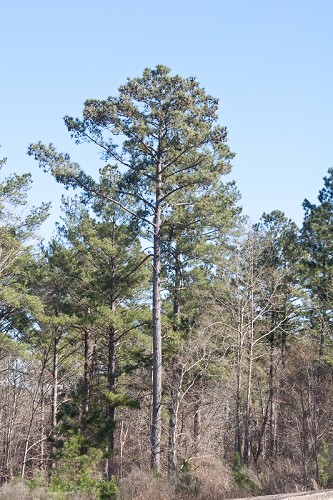Difference between revisions of "Pinus taeda"
Lsandstrum (talk | contribs) |
|||
| Line 32: | Line 32: | ||
==Ecology== | ==Ecology== | ||
===Habitat=== <!--Natural communities, human disturbed habitats, topography, hydrology, soils, light, fire regime requirements for removal of competition, etc.--> | ===Habitat=== <!--Natural communities, human disturbed habitats, topography, hydrology, soils, light, fire regime requirements for removal of competition, etc.--> | ||
| − | ''P. taeda'' proliferates in forests, fields, and pine plantations. <ref name= "Weakley 2015"> Weakley, A. S. (2015). Flora of the Southern and Mid-Atlantic States. Chapel Hill, NC, University of North Carolina Herbarium. </ref> Specimens have been collected from palm hammock ear edge of river, open pine woodland, small old field, mesic coastal palm oak hammock, loamy soil near small pond, palmetto flatwoods, open pasture, mixed hardwoods, and pine flatwoods. <ref name = "FSU herbarium"> URL: http://herbarium.bio.fsu.edu. Last accessed: June 2018. Collectors: Loran C. Anderson, R.K. Godfrey, Angus Gholson, Gary Knight, S.W. Leonard, Patricia Elliot, K. Craddock Burks, k. Studenroth, C. Florke, A.G. Shuey, J. Poppleton, D.B. Ward, S.S. Ward, T. Myint, P. Cmanor, S.Snedaker, Kurt Blum, J.M. Kane, T. MacClendon, K. MacClendon. States and counties: Florida (Franklin, Leon, Wakulla, Taylor, Gadsden, Leon, Jackson, Orange, Liberty, Levy, Jefferson, Lake, Escambia, Hamilton, St. Johns, Washington, Calhoun) Georgia (Thomas)</ref> | + | ''P. taeda'' proliferates in forests, fields, and pine plantations. <ref name= "Weakley 2015"> Weakley, A. S. (2015). Flora of the Southern and Mid-Atlantic States. Chapel Hill, NC, University of North Carolina Herbarium. </ref> Specimens have been collected from palm hammock ear edge of river, open pine woodland, small old field, mesic coastal palm oak hammock, loamy soil near small pond, palmetto flatwoods, open pasture, mixed hardwoods, and pine flatwoods. <ref name = "FSU herbarium"> URL: http://herbarium.bio.fsu.edu. Last accessed: June 2018. Collectors: Loran C. Anderson, R.K. Godfrey, Angus Gholson, Gary Knight, S.W. Leonard, Patricia Elliot, K. Craddock Burks, k. Studenroth, C. Florke, A.G. Shuey, J. Poppleton, D.B. Ward, S.S. Ward, T. Myint, P. Cmanor, S.Snedaker, Kurt Blum, J.M. Kane, T. MacClendon, K. MacClendon. States and counties: Florida (Franklin, Leon, Wakulla, Taylor, Gadsden, Leon, Jackson, Orange, Liberty, Levy, Jefferson, Lake, Escambia, Hamilton, St. Johns, Washington, Calhoun) Georgia (Thomas)</ref> When exposed to soil disturbance by military training in West Georgia, ''P. taeda'' responds negatively by way of absence.<ref>Dale, V.H., S.C. Beyeler, and B. Jackson. (2002). Understory vegetation indicators of anthropogenic disturbance in longleaf pine forests at Fort Benning, Georgia, USA. Ecological Indicators 1(3):155-170.</ref> |
===Phenology=== <!--Timing off flowering, fruiting, seed dispersal, and environmental triggers. Cite PanFlora website if appropriate: http://www.gilnelson.com/PanFlora/ --> | ===Phenology=== <!--Timing off flowering, fruiting, seed dispersal, and environmental triggers. Cite PanFlora website if appropriate: http://www.gilnelson.com/PanFlora/ --> | ||
Revision as of 19:18, 11 July 2019
Common name: loblolly pine [1], old field pine [1]
| Pinus taeda | |
|---|---|

| |
| Photo by John Gwaltney hosted at Southeastern Flora.com | |
| Scientific classification | |
| Kingdom: | Plantae |
| Division: | Magnoliophyta - Flowering plants |
| Class: | Magnoliopsida - Dicots |
| Order: | Pinales |
| Family: | Pinaceae |
| Genus: | Pinus |
| Species: | P. taeda |
| Binomial name | |
| Pinus taeda L. | |

| |
| Natural range of Pinus taeda from USDA NRCS Plants Database. | |
Contents
Taxonomic Notes
Synonyms: none
Varieties: none
Description
P. taeda is a perennial tree of the Pinaceae family native to North America. [2]
Distribution
P. taeda is found in the southeastern corner of the United States excluding Indiana and West Virginia. [2]
Ecology
Habitat
P. taeda proliferates in forests, fields, and pine plantations. [1] Specimens have been collected from palm hammock ear edge of river, open pine woodland, small old field, mesic coastal palm oak hammock, loamy soil near small pond, palmetto flatwoods, open pasture, mixed hardwoods, and pine flatwoods. [3] When exposed to soil disturbance by military training in West Georgia, P. taeda responds negatively by way of absence.[4]
Phenology
P. taeda has been observed flowering in March. [5]
Seed dispersal
This species is thought to be dispersed by wind. [6]
Fire ecology
P. taeda is fire resistant and has a high fire tolerance. [2]
Conservation and Management
P. taeda is listed as a weedy or invasive species by the Hawaiian Ecosystems at Risk Project Biological Resources Division. [2]
Cultivation and restoration
Photo Gallery
References and notes
- ↑ 1.0 1.1 1.2 Weakley, A. S. (2015). Flora of the Southern and Mid-Atlantic States. Chapel Hill, NC, University of North Carolina Herbarium.
- ↑ 2.0 2.1 2.2 2.3 USDA Plant Database https://plants.usda.gov/core/profile?symbol=PITA
- ↑ URL: http://herbarium.bio.fsu.edu. Last accessed: June 2018. Collectors: Loran C. Anderson, R.K. Godfrey, Angus Gholson, Gary Knight, S.W. Leonard, Patricia Elliot, K. Craddock Burks, k. Studenroth, C. Florke, A.G. Shuey, J. Poppleton, D.B. Ward, S.S. Ward, T. Myint, P. Cmanor, S.Snedaker, Kurt Blum, J.M. Kane, T. MacClendon, K. MacClendon. States and counties: Florida (Franklin, Leon, Wakulla, Taylor, Gadsden, Leon, Jackson, Orange, Liberty, Levy, Jefferson, Lake, Escambia, Hamilton, St. Johns, Washington, Calhoun) Georgia (Thomas)
- ↑ Dale, V.H., S.C. Beyeler, and B. Jackson. (2002). Understory vegetation indicators of anthropogenic disturbance in longleaf pine forests at Fort Benning, Georgia, USA. Ecological Indicators 1(3):155-170.
- ↑ Nelson, G. PanFlora: Plant data for the eastern United States with emphasis on the Southeastern Coastal Plains, Florida, and the Florida Panhandle. www.gilnelson.com/PanFlora/ Accessed: 24 MAY 2018
- ↑ Kirkman, L. Katherine. Unpublished database of seed dispersal mode of plants found in Coastal Plain longleaf pine-grasslands of the Jones Ecological Research Center, Georgia.